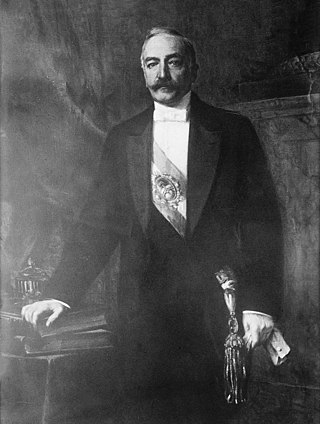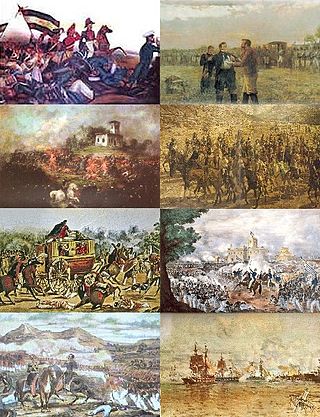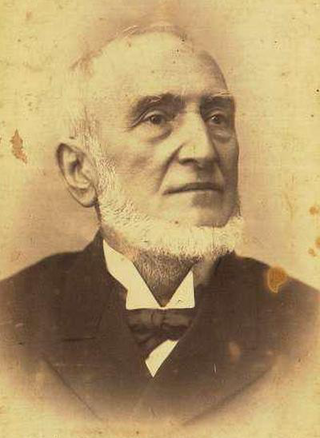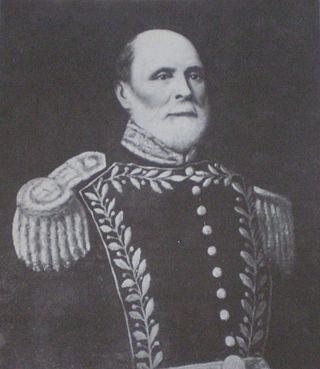Contents
This article relies largely or entirely on a single source .(November 2024) |
| |||||
| Decades: | |||||
|---|---|---|---|---|---|
| See also: | Other events of 1851 List of years in Argentina | ||||
Events in the year 1851 in Argentina .
This article relies largely or entirely on a single source .(November 2024) |
| |||||
| Decades: | |||||
|---|---|---|---|---|---|
| See also: | Other events of 1851 List of years in Argentina | ||||
Events in the year 1851 in Argentina .

Victorino de la Plaza was an Argentine politician and lawyer who served as President of Argentina from 9 August 1914 to 11 October 1916.

Roque José Antonio del Sagrado Corazón de Jesús Sáenz Peña Lahitte was an Argentine politician and lawyer who served as President of Argentina from 12 October 1910 to his death in office on 9 August 1914. He was the son of former president Luis Sáenz Peña. He was a candidate for an internal, modernist line within the National Autonomist Party.

Alejo Julio Argentino Roca Paz was an army general and statesman who served as President of Argentina from 1880 to 1886 and from 1898 to 1904. Roca is the most important representative of the Generation of '80 and is known for directing the Conquest of the Desert, a series of military campaigns against the indigenous peoples of Patagonia sometimes considered a genocide.
At the national level, Argentina elects a head of state and a legislature. The franchise extends to all citizens aged 16 and over, and voting is mandatory for all those who are between 18 and 70 years of age.

The Battle of Caseros was fought near the town of El Palomar, Argentina, on 3 February 1852, between forces of the Argentine Confederation, commanded by Juan Manuel de Rosas, and a coalition consisting of the Argentine provinces of Entre Ríos and Corrientes, the Empire of Brazil, and Uruguay.

Unitarianists or Unitarians were the proponents of the concept of a unitary state in Buenos Aires during the civil wars that shortly followed the Declaration of Independence of Argentina in 1816. They were opposed to the Argentine Federalists, who wanted a federation of autonomous provinces. Argentine unitarianism was an ideologic grouping, not a religious one. As such, it is unrelated to religious Unitarianism.

Brigadier General José María Paz y Haedo was an Argentine military figure, notable in the Argentine War of Independence and the Argentine Civil Wars.

The National Autonomist Party was the ruling political party of Argentina from 1874 to 1916.
Joaquín Madariaga was a soldier and Argentine politician. Madariaga was Governor of the Corrientes Province and leader of the provinces resistance against the national government of Juan Manuel de Rosas.

Ricardo Ramón López Jordán (1822–1889) was an Argentine soldier and politician, one of the last influential "caudillos" in the history of Argentina. He thrice rebelled against the government of Buenos Aires and was defeated in each attempt.

The Platine War was fought between the Argentine Confederation and an alliance consisting of the Empire of Brazil, Uruguay, and the Argentine provinces of Entre Ríos and Corrientes, with the participation of the Republic of Paraguay as Brazil's co-belligerent and ally. The war was part of a decades-long dispute between Argentina and Brazil for influence over Uruguay and Paraguay, and hegemony over the Platine region. The conflict took place in Uruguay and northeastern Argentina, and on the Río de la Plata. Uruguay's internal troubles, including the longrunning Uruguayan Civil War, were heavily influential factors leading to the Platine War.

The Argentine Civil Wars were a series of civil conflicts of varying intensity that took place through the territories of Argentina from 1814 to 1853. Beginning concurrently with the Argentine War of Independence (1810–1818), the conflict prevented the formation of a stable governing body until the signing of the Argentine Constitution of 1853, followed by low-frequency skirmishes that ended with the Federalization of Buenos Aires. The period saw heavy intervention from the Brazilian Empire that fought against state and provinces in multiple wars. Breakaway nations, former territories of the viceroyalty, such as the Banda Oriental, Paraguay and the Upper Peru were involved to varying degrees. Foreign powers such as the British and French empires put heavy pressure on the fledgling nations at times of international war.

The so-called Ejército Grande, also called the Ejército Grande Aliado Libertador, was the coalition army that in 1852, under the command of the governor of Entre Ríos, Justo José de Urquiza, invaded the provinces of Santa Fe and Buenos Aires and defeated Juan Manuel de Rosas's army, which until that moment was in command of the foreign relations of the Argentine Confederation.
The Battle of Caaguazú took place in Mercedes Department, in Corrientes Province, Argentina on 28 November 1841, during the Argentine Civil War, between the forces of Entre Ríos Province, commanded by brigadier Pascual Echagüe and Corrientes Province, under brigadier José María Paz, with a sound defeat of the Federal Party forces of Entre Ríos.

Pascual Echagüe, was an Argentine soldier and politician. He served as Governor of Entre Ríos and Santa Fe provinces and Minister of War and Navy during the governments of Urquiza and Derqui. He participated in the Argentine Civil Wars and the Uruguayan Civil War.

The Argentine Civil Wars were a series of internecine wars that took place in Argentina from 1814 to 1876. These conflicts were separate from the Argentine War of Independence, though they first arose during this period.
Events from the year 1914 in Argentina.

Nicanor Molinas was an Argentine lawyer, politician, and prominent official during the last years of the Argentine Confederation.

The Corrientes campaign or the Paraguayan invasion of Corrientes was the second campaign of the Paraguayan War. Paraguayan forces occupied the Argentinian city of Corrientes and other towns in Corrientes Province. The campaign occurred at the same time as the Siege of Uruguaiana.

Manuel Hornos (1807-1871) was an Argentine general who participated throughout the Argentine Civil Wars and the Paraguayan War. He was known for his service at the Battle of Tuyutí where he was a major contributor to the Argentine victory at the battle.